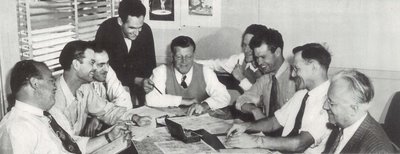
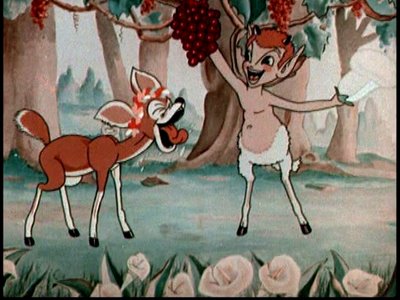 Get Out and Sell Those Cartoons! --- Part TwoTo update something mentioned in Part One, I did manage to have some conversations today with TV programmers from the Indianapolis area who gave me a vivid recap of what it was like buying and scheduling cartoon packages from the fifties through the seventies. According to these veterans, television appetite for kid product was insatiable. One independent manager recalled having three separate children's shows each day, and he was constantly on the lookout for animated material. Excessive repetition of cartoons was something to be avoided. Fresh stock was at a premium. A non-affiliated channel would buy up every package available, so long as the price was reasonable (although neither of the station managers I spoke to remembered playing that MGM 1960 group!). The deal on cartoons called for unlimited runs over a five to seven year license period. Terms were based on the size of your market. A typical group of several hundred cartoons might go for between ten and twenty thousand in the Indianapolis market. Salesmen were determined and persistent. A programming director received a half dozen "cold-calls" on any given day from field men dropping by after an appointment with a rival station. A lot of these guys were old theatrical drummers, and for some it was hard making the adjustment to TV sales. There were many occasions when they’d come through the door with no real knowledge of the product being offered, but armed nonetheless with a salesman’s bravado and the firm resolve to close a deal. One seller always wore a cape, which he removed with flourish upon entering the customer’s office. Another would follow any unsuccessful pitch by slamming shut his briefcase, snapping the fasteners, and apologizing with theatrical emphasis for not having done a better job for my company. These men sold the cartoons we watched every day on TV, but most didn’t know Droopy Dog from Dill Pickle. They might as well have been selling radial tires. A good field man was rewarded with placement in one of the major markets --- Chicago, LA, Houston. Beginners and non-starters scrambled amongst low wattage remnants, and that meant a lot of drive time hopscotching from one underfunded broadcaster to the next. Having bought a cartoon package, you were free to program it any way you liked. Goonland might play four times a week on the Popeye and Janie Show, while The Organ Grinder’s Swing never shows up once, but only because someone in the film room mislaid it among the Industry On Parade shorts. Rhyme and reason often went begging when it came to local programming. Employees in charge of projection would grab anything within reaching distance. You’d see Daffy Duck In Hollywood enough to figure it must be sitting beside the operator’s lunchbox, and he’s threading up that same cartoon day after day while finishing off his Little Debbie snack cakes.
Get Out and Sell Those Cartoons! --- Part TwoTo update something mentioned in Part One, I did manage to have some conversations today with TV programmers from the Indianapolis area who gave me a vivid recap of what it was like buying and scheduling cartoon packages from the fifties through the seventies. According to these veterans, television appetite for kid product was insatiable. One independent manager recalled having three separate children's shows each day, and he was constantly on the lookout for animated material. Excessive repetition of cartoons was something to be avoided. Fresh stock was at a premium. A non-affiliated channel would buy up every package available, so long as the price was reasonable (although neither of the station managers I spoke to remembered playing that MGM 1960 group!). The deal on cartoons called for unlimited runs over a five to seven year license period. Terms were based on the size of your market. A typical group of several hundred cartoons might go for between ten and twenty thousand in the Indianapolis market. Salesmen were determined and persistent. A programming director received a half dozen "cold-calls" on any given day from field men dropping by after an appointment with a rival station. A lot of these guys were old theatrical drummers, and for some it was hard making the adjustment to TV sales. There were many occasions when they’d come through the door with no real knowledge of the product being offered, but armed nonetheless with a salesman’s bravado and the firm resolve to close a deal. One seller always wore a cape, which he removed with flourish upon entering the customer’s office. Another would follow any unsuccessful pitch by slamming shut his briefcase, snapping the fasteners, and apologizing with theatrical emphasis for not having done a better job for my company. These men sold the cartoons we watched every day on TV, but most didn’t know Droopy Dog from Dill Pickle. They might as well have been selling radial tires. A good field man was rewarded with placement in one of the major markets --- Chicago, LA, Houston. Beginners and non-starters scrambled amongst low wattage remnants, and that meant a lot of drive time hopscotching from one underfunded broadcaster to the next. Having bought a cartoon package, you were free to program it any way you liked. Goonland might play four times a week on the Popeye and Janie Show, while The Organ Grinder’s Swing never shows up once, but only because someone in the film room mislaid it among the Industry On Parade shorts. Rhyme and reason often went begging when it came to local programming. Employees in charge of projection would grab anything within reaching distance. You’d see Daffy Duck In Hollywood enough to figure it must be sitting beside the operator’s lunchbox, and he’s threading up that same cartoon day after day while finishing off his Little Debbie snack cakes.


 Bravo to Warners for including so many MGM cartoons as extras with their classic DVD offerings. Several dozen have accumulated so far. I wish someone would compile an index of all the titles and where they’re located. I found The Milky Way with A Night At The Opera. Poor Little Me showed up with David Copperfield. I’ve tried to look at all of them, but I’m sure I missed some. Those Harman/Ising two-color Technicolor shorts are particularly interesting, coming about as the result of Metro's being foreclosed from using the new three-color system. Walt Disney had locked up exclusive rights after committing his Silly Symphonies to the process in 1932. This was a three-year deal, and no one else stood a chance competing with the rich, full palette of his already superior product. No matter how accomplished their animating skills, MGM artists couldn’t approach the Disney standard as long as they were restricted to such a limited spectrum. Tales Of the Vienna Woods and The Calico Dragon are notable, not for the colors they display, but for ones they cannot. I missed blue and yellow the most. You can’t blame it on bad prints, as these Warner transfers are the best available from original elements (note sample frames shown here). I played one of the Harman/Isings back-to-back with a Silly Symphony. The difference was night and day. Quality control was not a priority at Metro. You didn’t have someone like Walt riding herd to get out the best cartoon possible. He spent upwards of $50,000 on each subject by the mid-thirties. MGM tried to hold the line at less than half that. Average negative cost for the 1934-35 season was $15,209, and rentals averaged $44,157. Hugh Harman wanted to compete with Disney by spending more. His profligacy resulted in downward profit margins. 1935-36 saw costs rising to an average of $28,060, but at least three-color Technicolor was available, Disney’s exclusive license having expired. Subjects like Honeyland and Bottles give the Silly Symphonies a run for their money in terms of visual splendor. Developing ongoing characters for their cartoons was where MGM fell down. The Captain and The Kids was based on a comic strip that had been around forever, but audiences still weren’t buying. The Captain’s Christmas, at a negative cost of $27,419, brought back only $25,358 (the loss was even more keenly felt when you figured the total cost with prints, $38,605).
Bravo to Warners for including so many MGM cartoons as extras with their classic DVD offerings. Several dozen have accumulated so far. I wish someone would compile an index of all the titles and where they’re located. I found The Milky Way with A Night At The Opera. Poor Little Me showed up with David Copperfield. I’ve tried to look at all of them, but I’m sure I missed some. Those Harman/Ising two-color Technicolor shorts are particularly interesting, coming about as the result of Metro's being foreclosed from using the new three-color system. Walt Disney had locked up exclusive rights after committing his Silly Symphonies to the process in 1932. This was a three-year deal, and no one else stood a chance competing with the rich, full palette of his already superior product. No matter how accomplished their animating skills, MGM artists couldn’t approach the Disney standard as long as they were restricted to such a limited spectrum. Tales Of the Vienna Woods and The Calico Dragon are notable, not for the colors they display, but for ones they cannot. I missed blue and yellow the most. You can’t blame it on bad prints, as these Warner transfers are the best available from original elements (note sample frames shown here). I played one of the Harman/Isings back-to-back with a Silly Symphony. The difference was night and day. Quality control was not a priority at Metro. You didn’t have someone like Walt riding herd to get out the best cartoon possible. He spent upwards of $50,000 on each subject by the mid-thirties. MGM tried to hold the line at less than half that. Average negative cost for the 1934-35 season was $15,209, and rentals averaged $44,157. Hugh Harman wanted to compete with Disney by spending more. His profligacy resulted in downward profit margins. 1935-36 saw costs rising to an average of $28,060, but at least three-color Technicolor was available, Disney’s exclusive license having expired. Subjects like Honeyland and Bottles give the Silly Symphonies a run for their money in terms of visual splendor. Developing ongoing characters for their cartoons was where MGM fell down. The Captain and The Kids was based on a comic strip that had been around forever, but audiences still weren’t buying. The Captain’s Christmas, at a negative cost of $27,419, brought back only $25,358 (the loss was even more keenly felt when you figured the total cost with prints, $38,605).


 MGM made cartoons in order to resist the encroachment of double features. To persuade a theater not to book a second movie, they had to offer a complete program. Toward that end, the studio maintained a broad selection of miniatures (as shorts were often referred to in those days). Trade ads unmasked the evils inherent in combo billing, with the example shown here proposing an extreme remedy for one who has violated the orthodoxy of a well-balanced presentation. As long as they sought to provide an entire evening's bill of fare, MGM was obliged to make cartoons available to exhibitors. Once they established an in-house animation division in 1937 (its Culver City location shown here), the company was able to assure profits for their also-ran subjects. The Milky Way even managed to win the Academy Award for Best Animated Short Subject in 1940. This was an example of a Metro cartoon that made money and kept on making money. Initial negative cost was $29,416, and rentals for its first release were $44,060. A re-issue in 1948 yielded an additional $65,513. Ten years later (1958), $50,792 more. Finally in 1963, at a point when The Milky Way was presumably playing television (but in precious few markets!), another revival brought in $30,839. Quite a balance sheet, with theatrical rentals topping $200,000 on a negative investment of just $29,416.
MGM made cartoons in order to resist the encroachment of double features. To persuade a theater not to book a second movie, they had to offer a complete program. Toward that end, the studio maintained a broad selection of miniatures (as shorts were often referred to in those days). Trade ads unmasked the evils inherent in combo billing, with the example shown here proposing an extreme remedy for one who has violated the orthodoxy of a well-balanced presentation. As long as they sought to provide an entire evening's bill of fare, MGM was obliged to make cartoons available to exhibitors. Once they established an in-house animation division in 1937 (its Culver City location shown here), the company was able to assure profits for their also-ran subjects. The Milky Way even managed to win the Academy Award for Best Animated Short Subject in 1940. This was an example of a Metro cartoon that made money and kept on making money. Initial negative cost was $29,416, and rentals for its first release were $44,060. A re-issue in 1948 yielded an additional $65,513. Ten years later (1958), $50,792 more. Finally in 1963, at a point when The Milky Way was presumably playing television (but in precious few markets!), another revival brought in $30,839. Quite a balance sheet, with theatrical rentals topping $200,000 on a negative investment of just $29,416.
Photo CaptionsA Gathering Of Eagles: (left to right) Director Tex Avery; Background Artist Dan Shaffer; Story Man Harvey Eisenberg; Director Joseph Barbera; Producer Fred Quimby; Superintendent C.G. Maxwell; Director Bill Hanna; Sound Effects Technician F. McAlpin; Musical Director Scott Bradley.A Two-Color frame from Tales Of The Vienna Woods (1934)Producer Rudolph Ising, right, and W.D. Burness, animator.Producer Fred Quimby regards his Oscars.A Three-Color Technicolor frame from The Fishing Bear (1940)One-Sheet for Tee For TwoCo-directors Joe Barbera and William Hanna at work on Tom and Jerry.MGM's Animation BuildingTypical hard-hitting MGM Trade Ad denouncing double features.
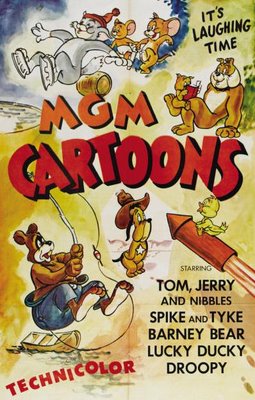
 Where Were Those MGM Cartoons When I Needed Them? --- Part One
Where Were Those MGM Cartoons When I Needed Them? --- Part One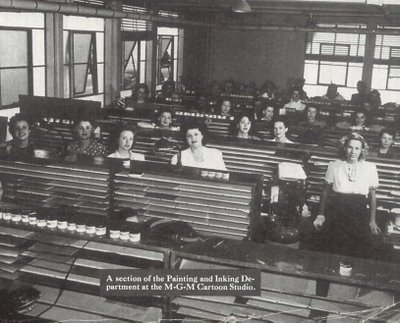 I’ll acknowledge having been a cartoon Main Titles junkie for virtually all of my life. Those logos and credits were actually more fulfilling than the short itself in many cases. Programs that excised openers and went straight to the body of the film were major downers. Walter Lantz introduced his Woody Woodpecker subjects, then went direct to a stark title card, omitting the credits. It wasn’t until these packages showed up in syndication around 1977 that I first saw a Universal logo on a Walter Lantz cartoon. Disney was as bad for depriving us of titles. The only time I can remember seeing Mickey, Donald, or Silly Symphonies on television was when one of the Mouseketeers took the little card out of its drawer to introduce that day’s cartoon. Was there even a main title on these? None that I recall, and I certainly don’t remember credits on any. Disney used shorts on the Sunday night NBC show as well, but often as not they’d fade up to the story from Walt's intro. It was only when I began collecting that I was finally able to see those neat RKO logos and United Artists legends on the main card of a W.D. subject. The frustration of going without credits was bad enough, but what about those cartoons that never showed up at all? For all I knew, Columbia never had its name on an animated product prior to Mister Magoo, and MGM’s only contribution was Tom and Jerry. I saw my first Metro Captain and The Kids shorts this morning on a DVD of A Day At The Races. I understand there were only fifteen of these, most in black-and-white. Does anyone remember seeing them in syndication? All we ever seemed to have around here in the way of vintage cartoons were Popeye and Warner Bros. Was it like this elsewhere, or was I merely deprived in North Carolina viewing markets? Metro shorts are a particular curiosity. After all, they made a lot of animated shorts. There’s not much information about the broadcast histories of those packages between the fifties and seventies (boy, would I love hearing from a station buyer from that period!), but apparently they were available from September 1960 …
I’ll acknowledge having been a cartoon Main Titles junkie for virtually all of my life. Those logos and credits were actually more fulfilling than the short itself in many cases. Programs that excised openers and went straight to the body of the film were major downers. Walter Lantz introduced his Woody Woodpecker subjects, then went direct to a stark title card, omitting the credits. It wasn’t until these packages showed up in syndication around 1977 that I first saw a Universal logo on a Walter Lantz cartoon. Disney was as bad for depriving us of titles. The only time I can remember seeing Mickey, Donald, or Silly Symphonies on television was when one of the Mouseketeers took the little card out of its drawer to introduce that day’s cartoon. Was there even a main title on these? None that I recall, and I certainly don’t remember credits on any. Disney used shorts on the Sunday night NBC show as well, but often as not they’d fade up to the story from Walt's intro. It was only when I began collecting that I was finally able to see those neat RKO logos and United Artists legends on the main card of a W.D. subject. The frustration of going without credits was bad enough, but what about those cartoons that never showed up at all? For all I knew, Columbia never had its name on an animated product prior to Mister Magoo, and MGM’s only contribution was Tom and Jerry. I saw my first Metro Captain and The Kids shorts this morning on a DVD of A Day At The Races. I understand there were only fifteen of these, most in black-and-white. Does anyone remember seeing them in syndication? All we ever seemed to have around here in the way of vintage cartoons were Popeye and Warner Bros. Was it like this elsewhere, or was I merely deprived in North Carolina viewing markets? Metro shorts are a particular curiosity. After all, they made a lot of animated shorts. There’s not much information about the broadcast histories of those packages between the fifties and seventies (boy, would I love hearing from a station buyer from that period!), but apparently they were available from September 1960 …
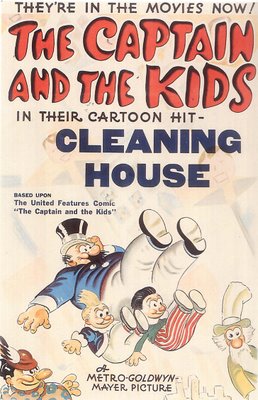

 MGM cartoons were supposedly the last of the major studios’ pre-1948 animated films released to television. The deal was struck with United Artists TV Distribution, but did not include the ongoing Tom and Jerry series, which remained a popular theatrical mainstay well into the sixties. From 1960, the Metros were leased to local stations as kiddie fodder, usually filling time between live host segments. Barney Bear was an umbrella title for some of these afternoon shows, as the package contained the first fifteen entries from that series, as well as thirteen MGM Bosko shorts, fifteen Captain and The Kids, and numerous Happy Harmonies produced by Hugh Harman and Rudolpf Ising. There were 135 cartoons in the group, and 120 were in color. By the time they became available, United Artists already had much larger packages of Popeye and Warner Bros. shorts in station berths across the country. The MGM subjects were in direct competition with name-brand animated products that had a four-year head start in clearing virtually every syndicated market in the nation. How could Barney Bear compete with Bugs Bunny? It must have been hard selling cartoons with no recognizable characters. UA salesmen in the field would have found it far easier to sell a Popeye group over these Metros. I’d assume MGM cartoons wound up with those stations that had been trumped in their respective market by rivals who’d grabbed off Bugs and Daffy before they could, but a question also arises as to what sort of terms UA exacted for the Metros. My guess would be high --- their lease with MGM was probably no bargain. Is this why so few of us saw these cartoons growing up? I’ve spent the last few days asking among friends around the country, and none of them recall seeing a Happy Harmonies on television (especially prior to the late seventies).
MGM cartoons were supposedly the last of the major studios’ pre-1948 animated films released to television. The deal was struck with United Artists TV Distribution, but did not include the ongoing Tom and Jerry series, which remained a popular theatrical mainstay well into the sixties. From 1960, the Metros were leased to local stations as kiddie fodder, usually filling time between live host segments. Barney Bear was an umbrella title for some of these afternoon shows, as the package contained the first fifteen entries from that series, as well as thirteen MGM Bosko shorts, fifteen Captain and The Kids, and numerous Happy Harmonies produced by Hugh Harman and Rudolpf Ising. There were 135 cartoons in the group, and 120 were in color. By the time they became available, United Artists already had much larger packages of Popeye and Warner Bros. shorts in station berths across the country. The MGM subjects were in direct competition with name-brand animated products that had a four-year head start in clearing virtually every syndicated market in the nation. How could Barney Bear compete with Bugs Bunny? It must have been hard selling cartoons with no recognizable characters. UA salesmen in the field would have found it far easier to sell a Popeye group over these Metros. I’d assume MGM cartoons wound up with those stations that had been trumped in their respective market by rivals who’d grabbed off Bugs and Daffy before they could, but a question also arises as to what sort of terms UA exacted for the Metros. My guess would be high --- their lease with MGM was probably no bargain. Is this why so few of us saw these cartoons growing up? I’ve spent the last few days asking among friends around the country, and none of them recall seeing a Happy Harmonies on television (especially prior to the late seventies).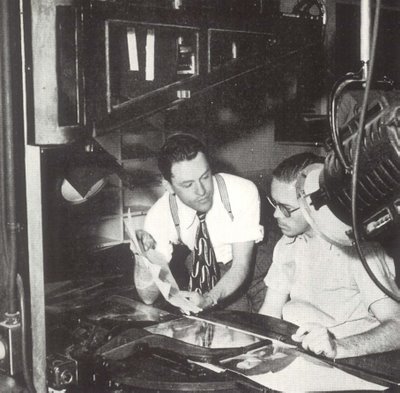
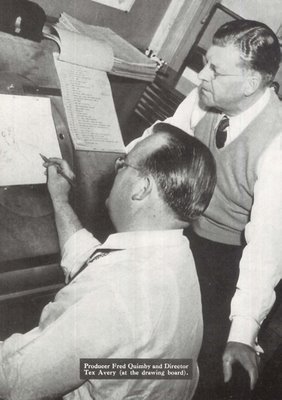
 Owning MGM cartoons on 16mm conferred bragging rights unequalled by the more commonplace WB’s. Finding them was near impossible. A company called Pictoreel sold Harman and Ising shorts (that's Harman and cameraman Jack Stevens in the photo above left) outright during the fifties, and home viewers could pick these up in either black-and-white or Kodachrome prints. It would appear the two producers retained some kind of distribution rights in these subjects, as other MGM cartoons were never legitimately available to collectors in 16mm. As for random or scattered prints (that is, ones mislaid or otherwise appropriated from TV stations or rental houses), you’d grab a Metro almost sight unseen in those days. Often as not, they’d be pink --- which is to say, the color was faded or fading. All were pigs in a poke since we’d seldom or never seen them before on TV. Much of the time, that was OK, but there were disasters. I scooped up six MGM’s around 1976 for $30 each, which wasn’t bad for such rarities. The first one I watched was The Old Plantation, which had all the rich animation and lavish backgrounds one might expect from Metro. Up next was a cartoon so dreadful that the mere recollection of it sets my teeth on edge. The Tree Surgeon was surely the most nauseating seven minutes I ever spent in front of a 16mm tri-pod screen. I still have flashbacks from the experience. My request to Warners --- now that you own this negative, please burn it. Collecting cartoons got easier when TV stations started dumping them in the late eighties. Suddenly, there were entire runs of Tom and Jerry (they’d finally gone off-network and into syndication in 1977), and even the legendary Tex Avery shorts were starting to turn up. Some friends and I used to meet a longtime collector/dealer on the third Saturday of each month at a Shoney’s restaurant near Charlotte. After lunch, he’d pop the trunk and we’d do a deal for MGM cartoons out in the parking lot. He had a friend at one of the TV stations and they were converting over to videotape for all their programming. What we got would have otherwise been earmarked for the dumpster, had not reason prevailed. There were VCR’s by then, but nothing approached the quality and purity of these classics on 16mm, and besides, the prints were in virtually new condition. It was only after all the TV stations/rental houses were emptied that the supply began to dwindle out. By then, so was collecting, for now there was video projection and the remarkable clarity of DVD. We’d have never imagined it would end, but now it pretty much has. The old Big Reel newspaper we anticipated with such fervor each month has slimmed down to wafer size, and whatever’s left of 16mm gathering is now largely confined to e-bay. It was all great while it lasted, but film couldn’t survive in the face of digital technology (even theatres are abandoning it now!). Some of you veteran collectors out there should write a history of that vanished era. In tomorrow’s Part Two, I promise not to digress so far from MGM cartoons, for there’s more info at hand about costs and rentals, as well as how the studio used their animated subjects as a battering ram against the despised double feature policy.
Owning MGM cartoons on 16mm conferred bragging rights unequalled by the more commonplace WB’s. Finding them was near impossible. A company called Pictoreel sold Harman and Ising shorts (that's Harman and cameraman Jack Stevens in the photo above left) outright during the fifties, and home viewers could pick these up in either black-and-white or Kodachrome prints. It would appear the two producers retained some kind of distribution rights in these subjects, as other MGM cartoons were never legitimately available to collectors in 16mm. As for random or scattered prints (that is, ones mislaid or otherwise appropriated from TV stations or rental houses), you’d grab a Metro almost sight unseen in those days. Often as not, they’d be pink --- which is to say, the color was faded or fading. All were pigs in a poke since we’d seldom or never seen them before on TV. Much of the time, that was OK, but there were disasters. I scooped up six MGM’s around 1976 for $30 each, which wasn’t bad for such rarities. The first one I watched was The Old Plantation, which had all the rich animation and lavish backgrounds one might expect from Metro. Up next was a cartoon so dreadful that the mere recollection of it sets my teeth on edge. The Tree Surgeon was surely the most nauseating seven minutes I ever spent in front of a 16mm tri-pod screen. I still have flashbacks from the experience. My request to Warners --- now that you own this negative, please burn it. Collecting cartoons got easier when TV stations started dumping them in the late eighties. Suddenly, there were entire runs of Tom and Jerry (they’d finally gone off-network and into syndication in 1977), and even the legendary Tex Avery shorts were starting to turn up. Some friends and I used to meet a longtime collector/dealer on the third Saturday of each month at a Shoney’s restaurant near Charlotte. After lunch, he’d pop the trunk and we’d do a deal for MGM cartoons out in the parking lot. He had a friend at one of the TV stations and they were converting over to videotape for all their programming. What we got would have otherwise been earmarked for the dumpster, had not reason prevailed. There were VCR’s by then, but nothing approached the quality and purity of these classics on 16mm, and besides, the prints were in virtually new condition. It was only after all the TV stations/rental houses were emptied that the supply began to dwindle out. By then, so was collecting, for now there was video projection and the remarkable clarity of DVD. We’d have never imagined it would end, but now it pretty much has. The old Big Reel newspaper we anticipated with such fervor each month has slimmed down to wafer size, and whatever’s left of 16mm gathering is now largely confined to e-bay. It was all great while it lasted, but film couldn’t survive in the face of digital technology (even theatres are abandoning it now!). Some of you veteran collectors out there should write a history of that vanished era. In tomorrow’s Part Two, I promise not to digress so far from MGM cartoons, for there’s more info at hand about costs and rentals, as well as how the studio used their animated subjects as a battering ram against the despised double feature policy.
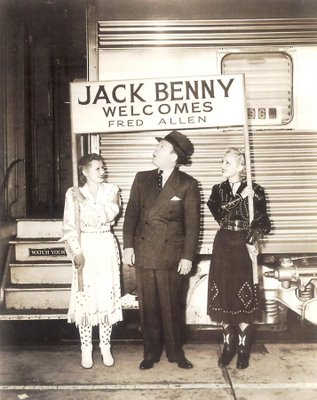
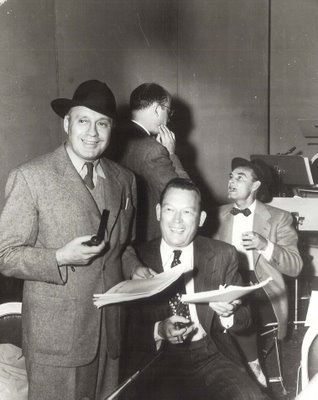 Recalling Fueds Of Long AgoThere was a time when every kid in the country knew all about the Jack Benny/Fred Allen feud. For years, it was a national fixation. Now both comedians are sadly forgotten, at least by younger generations. You’d have a hard time getting recognition signals at the mention of Allen’s name from even folks in their sixties. He’s been gone since 1956, and a lot of his radio humor seems droll to the point of abandoning comedy altogether. His legacy would seem to have become the chief concern of serious airwave archeologists, while Benny’s humor can still click with listeners otherwise disinterested in vintage broadcasting. Fox is releasing O.Henry’s Full House on DVD in a few weeks, an omnibus for which Fred Allen did one segment cut prior to release. The Ransom Of Red Chief was only seen during a few initial engagements in 1952, but apparently it still exists. The director was Howard Hawks, which is reason enough to restore the footage. As it is, the title O.Henry’s Full House is itself a misnomer, since there are actually only four stories in the show as presently constituted. I’d like to think Fox has remedied that, but nothing in the DVD announcements would indicate they have. Update --- as of 8:12 a.m., there have been several readers who report having seen O.Henry's Full House on television, complete with the Fred Allen story, so I'm happy to report I'm mistaken as to its latter-day absence. The question now is this --- when did Fox put the segment back into the feature, as it was definetely cut for general theatrical release ... ?
Recalling Fueds Of Long AgoThere was a time when every kid in the country knew all about the Jack Benny/Fred Allen feud. For years, it was a national fixation. Now both comedians are sadly forgotten, at least by younger generations. You’d have a hard time getting recognition signals at the mention of Allen’s name from even folks in their sixties. He’s been gone since 1956, and a lot of his radio humor seems droll to the point of abandoning comedy altogether. His legacy would seem to have become the chief concern of serious airwave archeologists, while Benny’s humor can still click with listeners otherwise disinterested in vintage broadcasting. Fox is releasing O.Henry’s Full House on DVD in a few weeks, an omnibus for which Fred Allen did one segment cut prior to release. The Ransom Of Red Chief was only seen during a few initial engagements in 1952, but apparently it still exists. The director was Howard Hawks, which is reason enough to restore the footage. As it is, the title O.Henry’s Full House is itself a misnomer, since there are actually only four stories in the show as presently constituted. I’d like to think Fox has remedied that, but nothing in the DVD announcements would indicate they have. Update --- as of 8:12 a.m., there have been several readers who report having seen O.Henry's Full House on television, complete with the Fred Allen story, so I'm happy to report I'm mistaken as to its latter-day absence. The question now is this --- when did Fox put the segment back into the feature, as it was definetely cut for general theatrical release ... ?



















